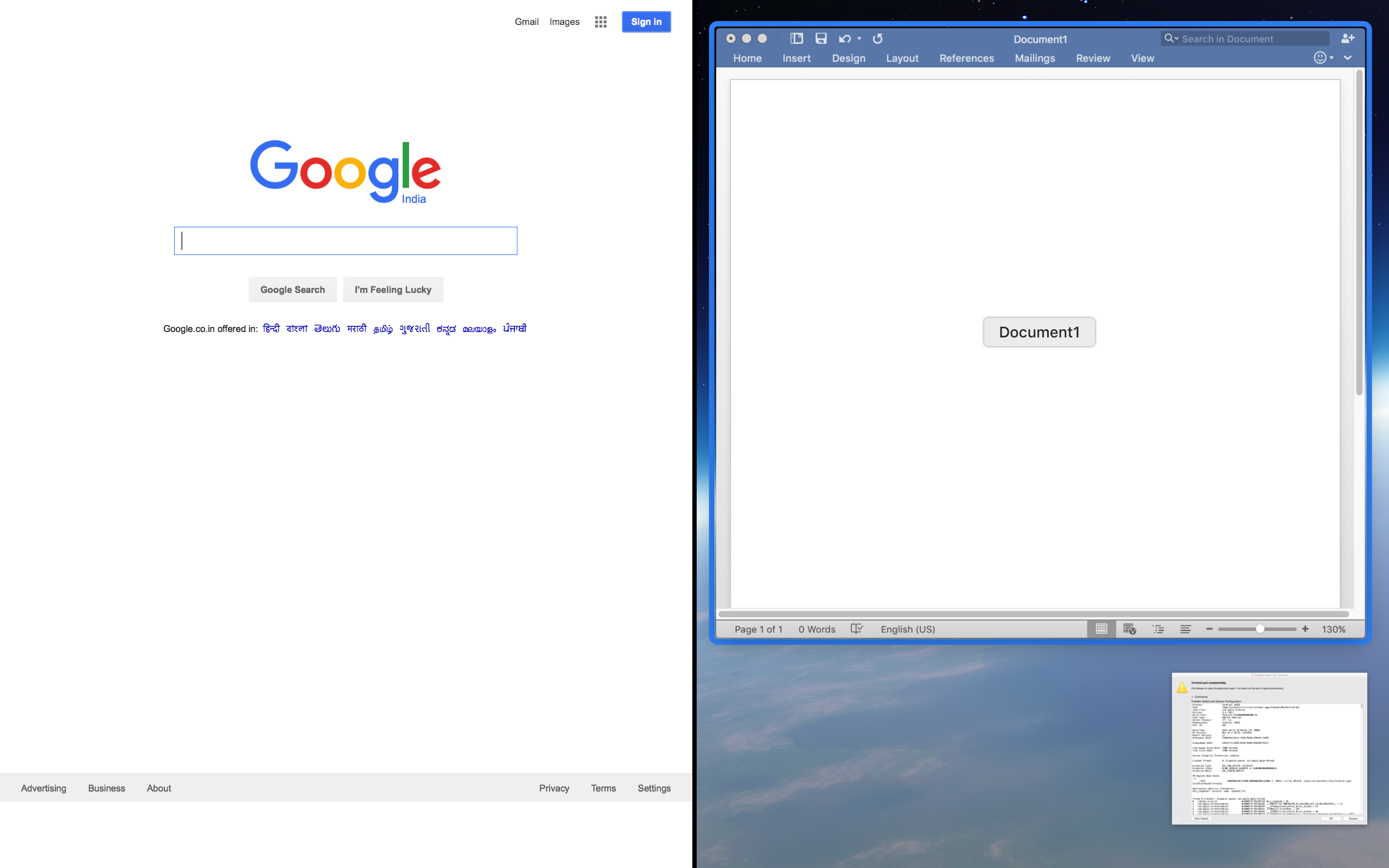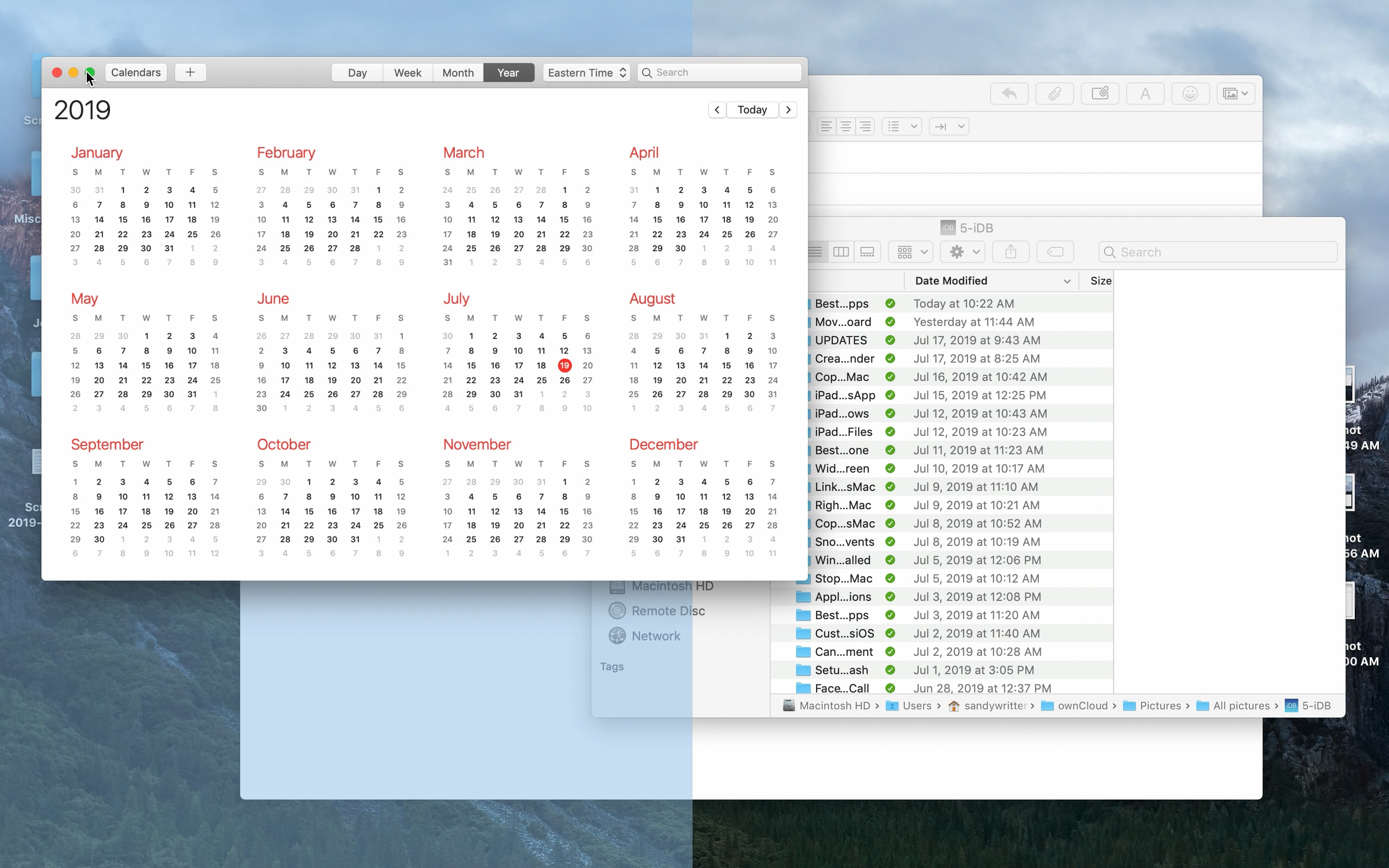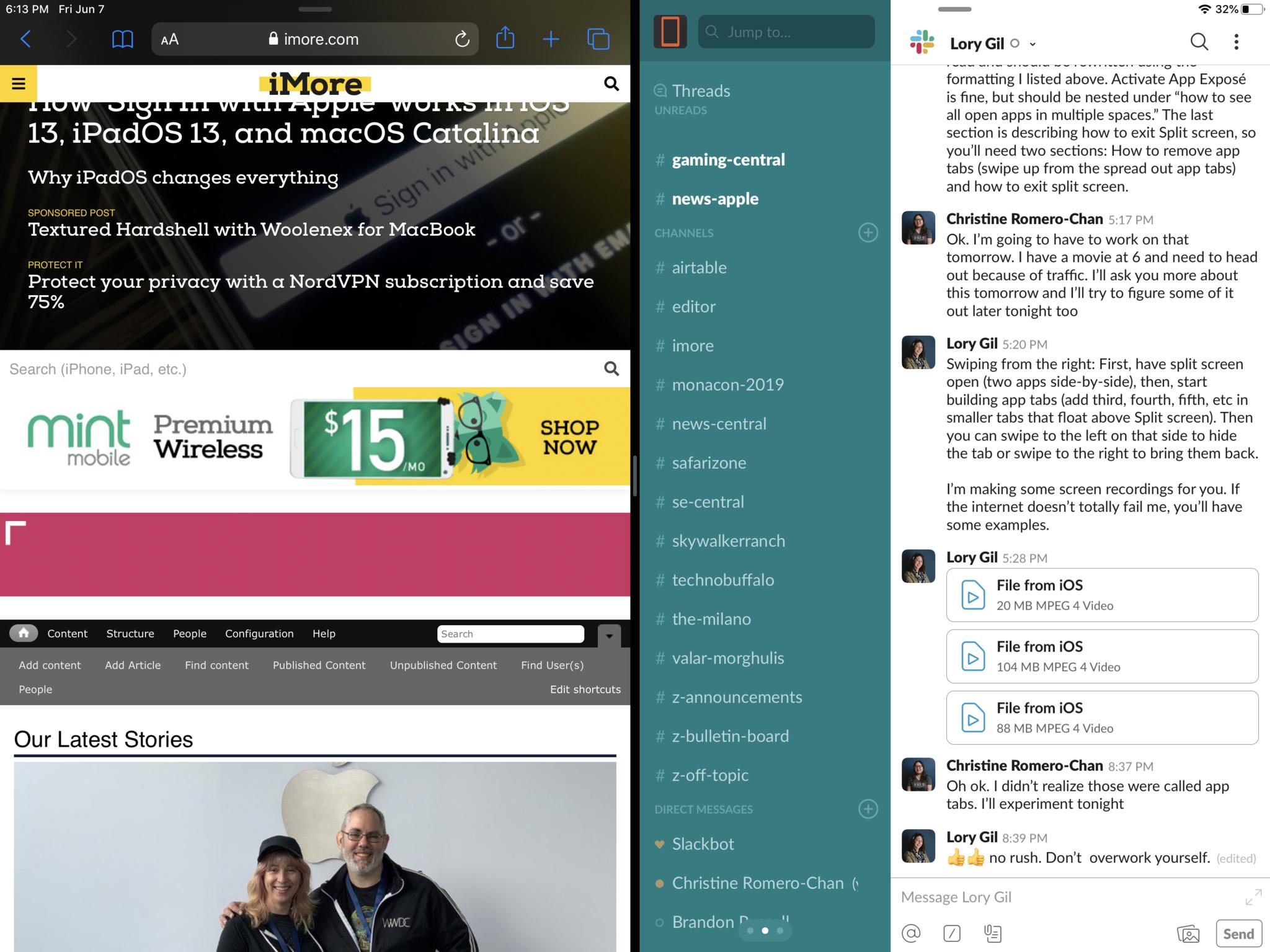If you have a high resolution LCD or LED screen at home and you are not using any kind of screen splitting application, then you are wasting your screen real estate big time! The best thing about having a high resolution screen is that you can see multiple windows at the same time, instead of just one active program at a time.
Of course, you can always switch between programs by using ALT + TAB or by simply clicking on the program in the taskbar, but there are many times when you need to be able to see multiple programs at the same time. The latest operating system from Microsoft, Windows 10, not only has built-in support for multiple desktops, but it also has added a couple of nice features to the Snap feature that was included starting in Windows 7.
Mar 10, 2020 Of course this is covering split screen apps on iPad, but Split Screen features exist for the Mac too, and not just by having multiple app windows open at the same time. You can learn how to use Split View apps on Mac OS here if that interests you, it’s fairly similar to how it looks and behaves on iPad. Dec 18, 2019 Hover your pointer over the full-screen button in the upper-left corner of a window. Or click and hold the button. Choose ”Tile Window to Left of Screen” or ”Tile Window to Right of Screen” from the menu. The window then fills that side of the screen. Click a window on the other side of the screen to begin using both windows side by side.
In this article, I’m going to write about the new features in Windows 10 and also about a couple of freeware programs that also let you split your screen in different ways. If you’re not already familiar, read my previous post on how to use the Snap feature in Windows 7 and Windows 8.
Windows 10 New Snap Features
First, let’s talk about Windows 10 because it has some really nice new features for working with multiple windows on the same desktop. As you already know, you can simply drag a window to the far left or far right of the screen and Windows will automatically resize that window to fill half the screen.
The same is true for Windows 10, but now there is a new Snap Assist feature that also shows you the extra windows on the opposite side as thumbnails and lets you click on them to fill the other side of the screen. In Windows 7 & 8, you had to manually snap the second window into place too.
As you can see above, once I dragged and dropped Excel on the right side of the screen, the other open windows were automatically shown on the left side. Clicking on any of the windows will expand it to fill the entire left portion of the screen.
Another new option is the 2×2 grid. If you take a window and drag it to any corner of the screen, the window will fill up that particular corner or 1/4 of the screen. You can fill each corner with a desktop app or universal Windows app. In Windows 10, all apps act like desktop apps, so they can be snapped anywhere too.
As you can see above, I have two apps snapped on the right side and one app on the left side. It’s worth noting that the preview build of Windows 10 also supported vertical snapping, meaning the app would end halfway down the screen and go across horizontally, but that seems to have been removed in the final build.
With Windows 10’s new snap options and virtual desktop manager, most people won’t ever need to bother downloading a third-party app to manage their windows.
Freeware Apps
There are also two freeware apps you can use to divide or split your screen into multiple parts and therefore work more efficiently. Earlier I had written about a program called SplitView, which lets you split your screen, but it costs $39! Why pay when you can get something better for free?
WinSplit Revolution is a very small utility that helps to organize all your open windows by tilting, resizing and positioning them so that they efficiently use all the space on your desktop.
Using WinSplit Revolution, you can quickly split your screen into two halves, thirds, fourths, etc. You can resize any window and move it to the left half of the screen, the top, the bottom, a corner, etc.
Then using either a virtual number pad or predefined hotkeys, you can quickly bring up a window to fullscreen or switch to another window.
The program is nicely implemented and has a good number of useful features:
- Automatically handles window resizing, moving, closing, etc
- Quick access via global hotkeys and virtual numpad
- Automatic startup and update
- Drag and drop windows into different sections
- Fusion between two windows (splits two program vertically and allows you to use a middle bar to adjust the size)
- Mosaic mode – Splits the screen into nine equal parts and will place one window into each section. If you have less than nine windows open, it will adjust the size of the mosaic to make the windows larger.
GridVista is the second program that allows you to divide or split your Windows desktop screen into multiple parts. I mentioned WinSplit first because it seems to have more features than GridVista.
You can again use it to split your screen into halves, thirds, etc. just like WinSplit, but it does not have a virtual keypad. Simply drag a window into any of the sections and it will maximize to the full size of that section.
You can then maximize any of the sections to full screen either via clicking with the mouse or via hotkey. So if you have a large monitor over 20”, then you should definitely check out either of these programs.
Overall, both programs work well in Windows XP, Vista, and 7, so you can play around with both and see which one works out better for you. The only downside to these freeware apps is that they are old and not developed anymore. For example, MaxTo has actually replaced WinSplit, but I don’t think it’s worth the money. The freeware apps work, but not as useful on new operating systems like Windows 8 and 10. Enjoy!
Mosaic for windows management
What tricks do you have in your bag to stay productive for extended periods of time? Some will say: single focus, no distractions, away from computers — and right into the Bronze Age. Because, let’s admit it, shutting everything down is simply not a viable solution for the modern workplace.


Today, our multifaceted responsibilities require us to have multiple windows open on our Macs at all times, fending off never-ending Slack messages while writing emails and managing our calendars. Looking from the sidelines, it might seem that what we do all day is just switching between full-screen app windows.
Split screen app + 170 goodies for Mac
Download Setapp to get access to Mosaic and a whole lot of Mac apps that will help you solve everyday tasks.
For years, our natural desire was to get more screen real estate by adding a second, third, and even fourth monitor. Numerous guides on how to do dual screen on Mac properly suggested a variety of ways in which screens could add to our working lives.
In the end, portability and convenience won when most of us switched to predominantly working on our laptops. But accomplishing the same amount of work with a smaller screen got even more challenging. That all changed as Apple released its OS X El Capitan in 2015.
How To Do Split Screen On Mac
Starting El Capitan, all versions of macOS have included a MacBook split screen feature called Split View, which lets you easily open two apps to fill the whole screen and adjust them as needed.
To activate Mac split screen:
- Open two apps of your choice
- Hold the green “full-screen” button at the top left of the screen
- Drag the app to fill either the left or right side of the screen
- Click on the other app for it to fill the rest
Note: some older, not frequently updated apps might not support Split View.
Feel free to experiment with various app combinations that would fit your work the best. If you need to see more than two apps, you can easily create another Split View on a new Desktop. To do that, just launch the Mission Control utility and click on the plus icon in the top-right corner of the screen. If you’re wondering how to switch screens on Mac in Split View, you can either go through the Mission Control or swipe left or right with four fingers as a shortcut.
To change the portion of the screen used by each app, simply drag the divider in the center to either side. To quit Split View, either press Escape, the same green “full-screen” button, or use a shortcut Ctrl + ⌘ + F.

Use better Mac split screen alternatives
The Split View Mac provides by default is arguably twice as good as using just one app at a time. But it doesn’t go beyond that. What about four, six, or eight times the productivity? Alas, the Split View can’t give us that — it’s only up to third-party utilities to fix.
Best app for splitting screen on Mac
Get Mosaic, the most robust split view tool. Tons of layout arrangements and ease of use while managing windows on Mac.
Mosaic is a Split View Mac alternative and most likely the last window manager you’ll ever need. Unlike Split View, Mosaic supports any kind of layout arrangement, whether you want to divide your screen in rows, squares, columns, or a completely custom grid.
To split screen on Mac with Mosaic:
- Make sure Mosaic is launched in your menu bar
- Simply drag your app windows onto the preferred setup
You can also create new Mac split screen configurations by clicking on the Mosaic menu bar icon and then Preferences ➙ Quick Layout.
With Mosaic you can customize your screen to fit your needs precisely and thus considerably increase your productivity. As a bonus, when you find the original Mac split screen not working or being unresponsive, Mosaic can be the answer, as it’s based on a third-party technology and is compatible with all apps.
Create and save custom workspaces
While using Mosaic as a better Split View Mac alternative will help you keep all the app windows in place, reopening every app and file you need for your work can take lots of time.
Workspaces is an automated solution that lets you create custom workspaces for all major activities. It allows you to bring apps, websites, files, emails, and whatever relates to a project or task into handy spots. For example, if you’re about to code something, you can get Workspaces to open your text editor, FTP transfer app, Terminal, your framework of choice documentation in Chrome, and anything else you regularly use.
With Workspaces, you can curate as many project toolkits as you like and switch between them with ease. Every workspace is available from the menu bar. Best of all, you can set up automatic activation for those workspaces that are always associated with a specific type of task.
Mac Screen Split App
To create a new workspace in Workspaces, click on the app menu bar icon and select Edit. Then simply add any app or file via the plus button — you can drag and drop the items that are stored on your Mac and paste or type websites. That’s it.
Just like that you can compartmentalize all your work into categories and open all the materials you need in one click.
Lg Screen Split Mac
Do more with Mac split screen and workspaces
The Split View Mac supplies by default is a definite boost to your productivity in the today’s work environment. However, if you need more flexibility in how precisely you configure the app window arrangement, look no further than Mosaic.
Mac Split Screen 3 Apps
In addition, combine everything you need into detailed packages and call on them at any time using Workspaces. This way you can easily divide responsibilities or separate work from personal life. Most importantly, you stop wasting time on opening all the right documents and turn on the always “ready to go” state.
Best of all, both Mosaic and Workspaces are available for a free trial through Setapp, a platform of more than 180+ Mac apps that cover productivity, task management, creativity, and more. Arm yourself with the utilities you need to go through your day in the productive state of flow.